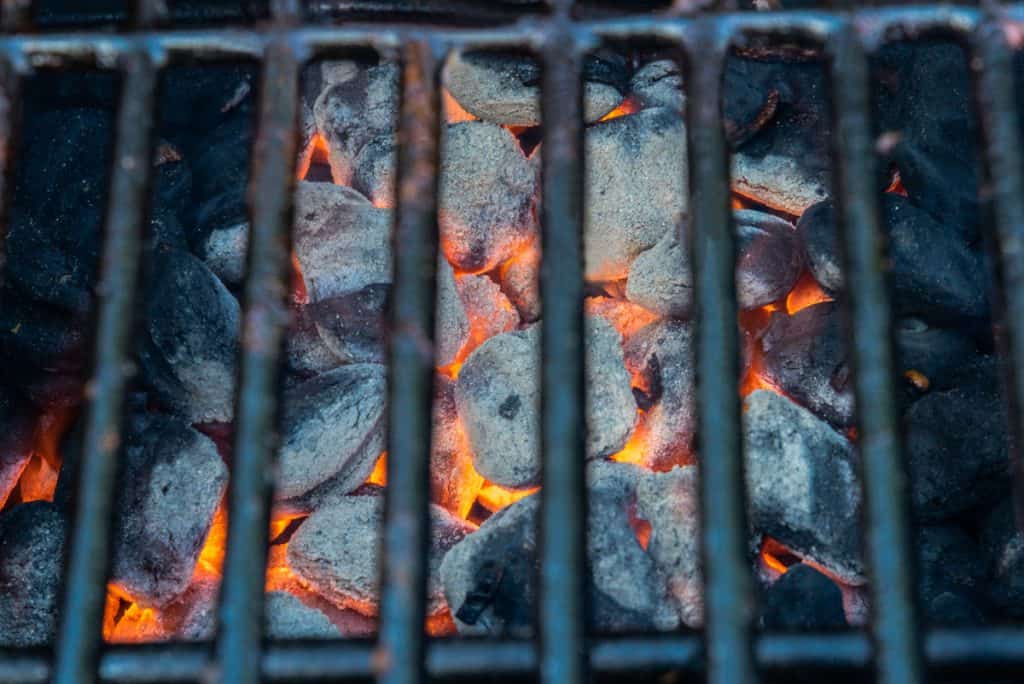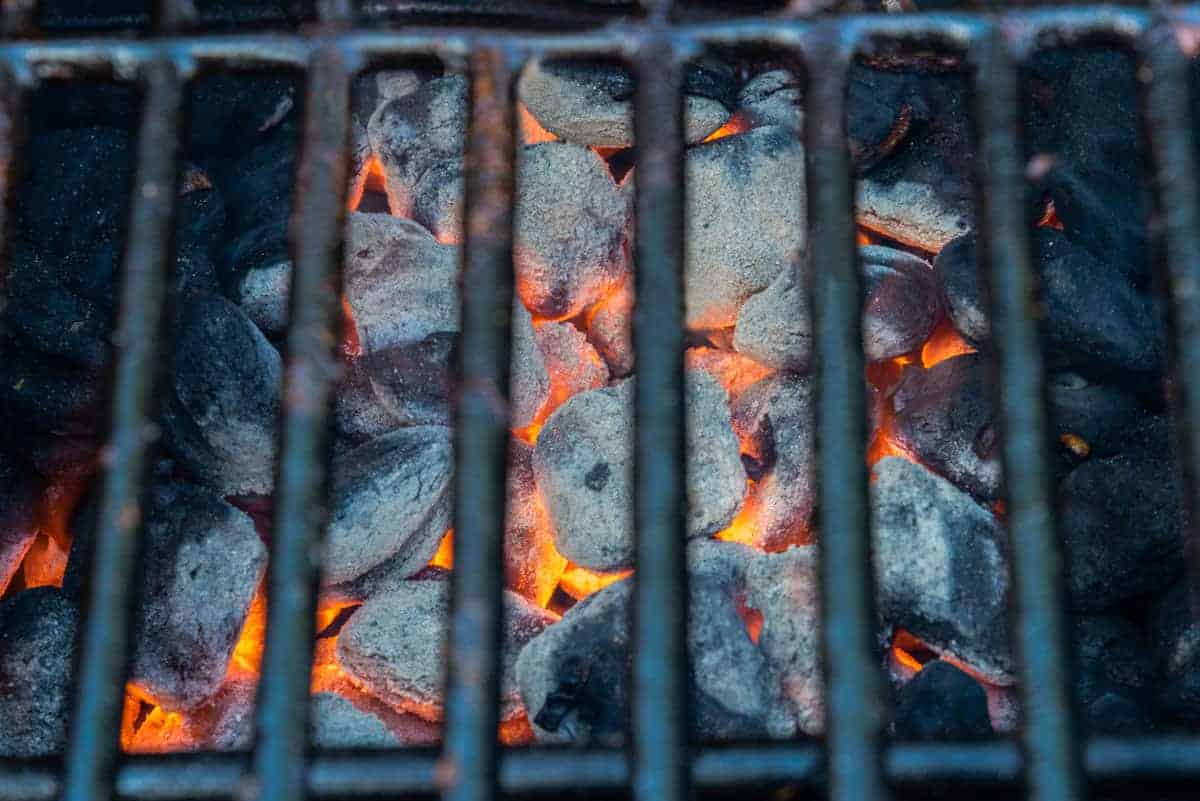It’s important to know how to build a proper charcoal fire, but it’s just as important for the coals to hold their heat long enough to cook your food. This is a particular concern if you like to host long afternoon barbecues, as we do. How long does a charcoal grill stay hot once the coals are lit? Let’s take a look.
Building the Perfect Fire
Before you can worry about maintaining the fire, you’ll have to get it started properly. First, open the vents so that the fire will have enough oxygen to burn properly. Once the fire is lit, you can adjust them further to maintain the temperature you want. The wider the vents are, the hotter your fire will be.

Choose which type of coal you’d like to burn. Charcoal briquettes are easy to find, inexpensive, and provide steady, even heat. Lump charcoal will provide you with a hotter, cleaner fire, but the coals will burn out more quickly. Whichever type you choose, make sure it’s a high-quality brand. Cheap charcoal will deliver inconsistent results.
Next, light the coals. We would recommend using a chimney starter for this step, as this eliminates the need for lighter fluid. To do this, place a sheet or two of crumpled newspaper in the bottom of the chimney, just beneath the wire rack. Fill the chimney with coals and remove the top grate from the grill. Set the chimney in the base of the grill and use a stick lighter or long match to carefully set the newspaper alight.
After about 25 minutes, the coals should be coated in a thin layer of silvery ash. Wearing heatproof grill gloves, take the chimney by the handle and pour the hot coals into the cooking chamber before replacing the top grill rack.
Wait a few minutes to allow the grill to heat up before oiling the rack and adding the food as you normally would.
Note: Don’t be tempted to empty the coals into the grill before they’ve had a chance to ash over. If the coals are still black, they’ll continue to heat up, making it difficult for you to control the cooking temperature.
How Long Does a Charcoal Grill Stay Hot?
A properly built fire should stay hot enough to cook for 30-40 minutes. If you plan to keep cooking beyond this point, you’ll have to enlist one of the following techniques to maintain the grilling temperature.
Stoking
In the short term, you can help the coals stay hot by stoking them. Use a grilling tool to prod and rotate the coals. This will expose the embers to the air and allow them to briefly ignite again, thereby increasing the temperature of the grill. Stoking the coals will also allow the food to cook more evenly.
As you stoke the coals, remember to adjust the vents to ensure proper airflow. If the fire burns out completely, you’ll have to restart it. This will get harder and harder each time, so try to get it right on the first attempt. You don’t want the coals to be used up before they’ve gotten hot enough for cooking.
Adding Lighter Fluid
If stoking the coals isn’t working and you have lighter fluid on hand, you can use it to give the fire the boost it needs. Carefully pour small amounts of fluid in several spots around the grill, making sure not to use too much or stand too close. If the coals don’t ignite at once, relight them using a stick lighter or long match.
Lighter fluid related articles:
- How to start a charcoal grill without lighter fluid
- Charcoal lighter fluid substitutes
Adding Newspaper
If you’re trying to maintain a hot or medium-hot fire, adding newspaper is an excellent way to do it. Keep a stack nearby and place a few crumpled sheets on top of the coals from time to time to keep the flames burning. Because it burns out quickly, it should keep the temperature at the level that you want it, without getting so hot that it scorches the meat. The newspaper technique is also a great way to equalize the temperature if you have one segment of the grill that’s cooling off too fast.
Adding Coals
The main thing to remember is that a fire will only burn as long as it has the fuel required to do so. If you simply let your coals burn out, then the grill will continue to emit a faint amount of heat for about 15 minutes or so before it starts to cool completely. Therefore, if you want your charcoal grill to stay hot for a long period of time, you’ll have to keep adding more coals.
When the embers begins to die down, add 10-12 fresh coals to the perimeter of the fire. Open the vents as far as they can go so that the new coals will have a chance to ignite, then adjust them as the grill approaches your desired temperature.
When the new coals are about two-thirds covered with silvery ash, use a set of heatproof tongs to move them to the center of the fire. This process can be repeated every 30 minutes as needed.
Note: Depending on your plans, you might need to invest in an extra supply of charcoal beforehand. If you’re planning to prepare a whole brisket, you’ll need the grill to stay hot for a lot longer than if you were simply grilling a few hot dogs.
About Cooking Temperatures

Now that you know how to maintain the temperature of your coals, the question remains: What foods should be cooked at which temperatures? Here’s a quick rundown to help you perfect your technique.
High Heat
It only takes about 10 minutes for a charcoal grill to get hot enough to cook foods at high heat. If this is your goal, we would recommend using the two-zone technique when stacking the coals. To do this, create a taller stack of coals on one side of the grill, with a lower stack on the other. This will allow you to sear foods quickly at high heat, then remove them to the cooler side to finish cooking.
High heat is ideal for steaks, burgers, and bone-in pork chops. Hardy vegetables, such as carrots, onions and corn on the cob, can also withstand hot temperatures. If you find that the food isn’t browning quickly enough, open the vents to increase the airflow. Note that while steaks and chops should be finished over the cooler section of the grill, the vegetables should be ready as soon as they’ve achieved decent grill marks.
Medium Heat
For medium heat, there’s no need to worry about creating a two-zone fire. Simply wait 25-30 minutes before adding food to the grill.
This is the preferred temperature for veggies like asparagus and eggplant, as well as proteins such as chicken, fish, and boneless pork chops. We would also recommend it for precooked sausages like bratwurst and hot dogs.
If your food is marinated, it’s a good idea to use medium to medium-high heat. This is because the sugars in the marinade will burn if the fire is too hot.
Low Heat
It can be difficult to maintain low heat in a charcoal grill, which is why many pitmasters prefer gas or pellet grills for long cooking applications like smoking. However, it is possible to keep your fire burning at about 225 degrees Fahrenheit for long enough to make smoked brisket or pork shoulder.
To do so, you’ll need to build a two-zone fire as described in High Heat, above.
Place the ingredients on the cooler side of the grill. After about three hours, it will be time to start replenishing the coals. For this application, we would recommend lighting the coals in the chimney starter before adding them to the fire. Otherwise, the combustion might raise the temperature of the grill by too much.
If you’d like to use a charcoal grill for smoking, take a look at this instructional video before getting started.
One final tip: When the embers have died down enough for you to hold your hand a few inches away for longer than five seconds, it’s the perfect time to break out the marshmallows.
A Word About Ash Removal
When you’ve finished cooking, you’ll be left with a pile of gray ash—the remains of the burned-out charcoal. Once the grill has had a chance to cool, remove as much of this residue as possible. Too much ash will block the air vents, effectively smothering your next fire before it has a chance to start.
After removing the ash, clean the grill racks using a stiff wire brush. This will remove any food residue so you’ll be all set to enjoy your next cookout.
FAQs
How can I be sure the fire is hot enough for cooking?
A thermometer is the most convenient way to ensure that your fire is burning at the correct temperature. If your grill isn’t equipped with a built-in thermometer, we would recommend investing in a stand-alone unit.
Be aware, however, that lid thermometers aren’t always accurate, as the probe is closer to the lid than the cooking surface itself. With practice, you’ll be able to tell whether or not the fire is ready for cooking.
Is it all right to use old charcoal for grilling?
This is a bad idea for two reasons. Number one, old charcoal is much harder to set alight. Number two, it won’t stay hot long enough to cook the food properly. If your charcoal has been sitting around for awhile, it’s best to buy a new batch.
What should I do if the charcoal is damp to the touch?
Depending on where you store your charcoal, sometimes it can get moldy or damp. If this happens, discard the coals and get a new batch. Damp coals won’t be able to ignite, and even if you do manage to get a blaze going, they won’t hold their temperature.
Can you put frozen food on the grill?
This practice isn’t recommended, as the food could be perfectly cooked on the outside while still raw or frozen inside—a situation that’s dangerous as well as undesirable. If there’s no way to avoid it, use a two-zone fire to start cooking the food at a lower temperature, and increase the cooking time accordingly. You may need to add more charcoal to keep the fire burning long enough for the food to cook through.
Does high altitude affect the grill temperature?
It can. At altitudes above 5,000 feet, the atmosphere has less oxygen, which can make it difficult for charcoal to burn hot enough for cooking. For high-altitude grilling, make sure the dampers are opened as wide as they’ll go, and keep the grill clean between uses.
What if I’m using a drip pan?
Drip pans can also restrict oxygen flow, so keep the pan as far away from the dampers as possible. We would also recommend using a smaller drip pan so as not to obstruct the cooking surface.
Final Thoughts
How long does a charcoal grill stay hot? That depends on the amount of work you’re willing to put into it. Following the tips we’ve outlined above will help you keep the blaze going for as long as necessary.

Related articles:
- How to use wood pellets in a charcoal grill?
- How to use wood chips on a charcoal grill?
- Can you put wood chips directly on charcoal?
- Lump charcoal vs. briquettes
Happy grilling!



